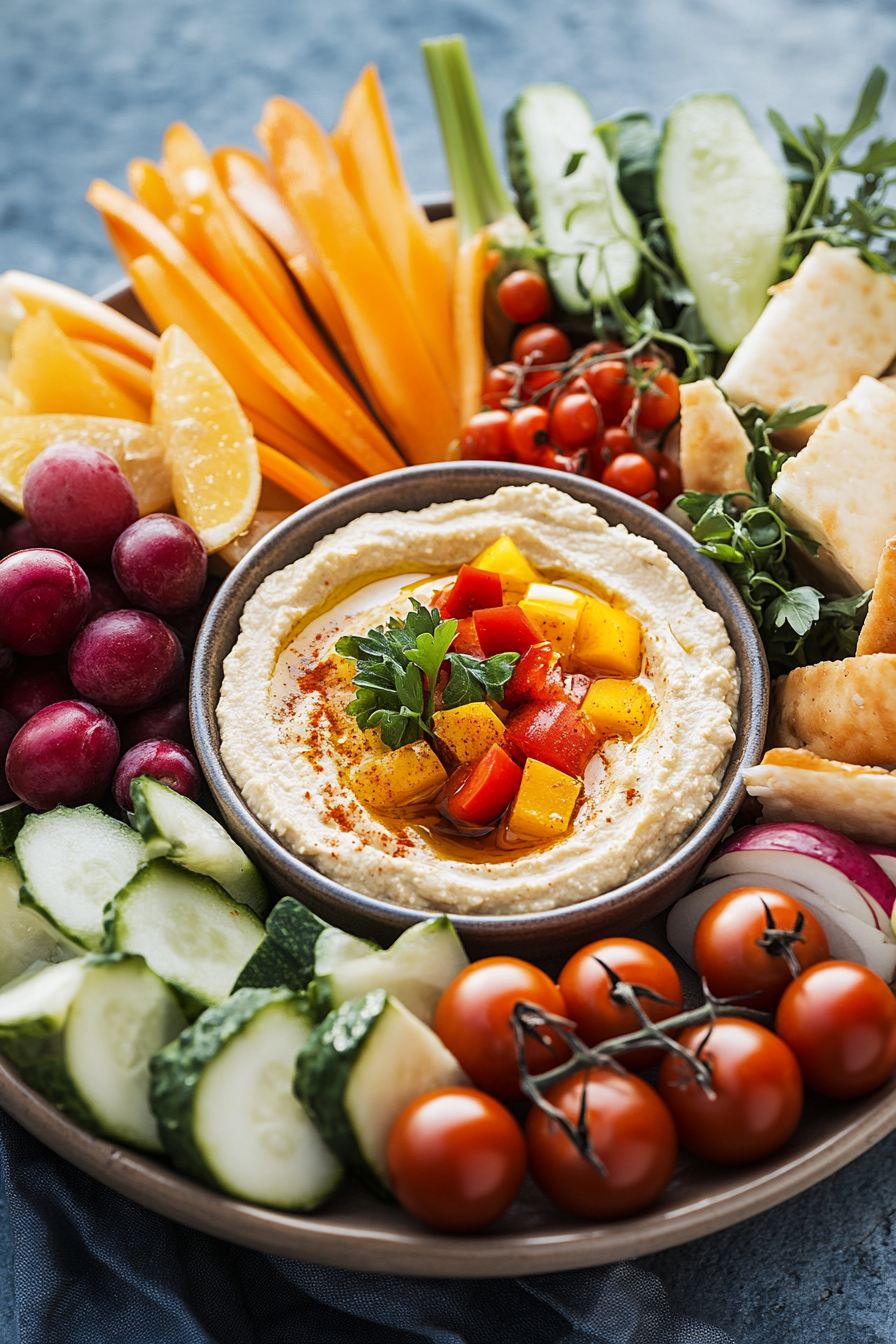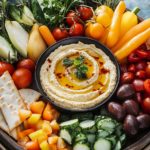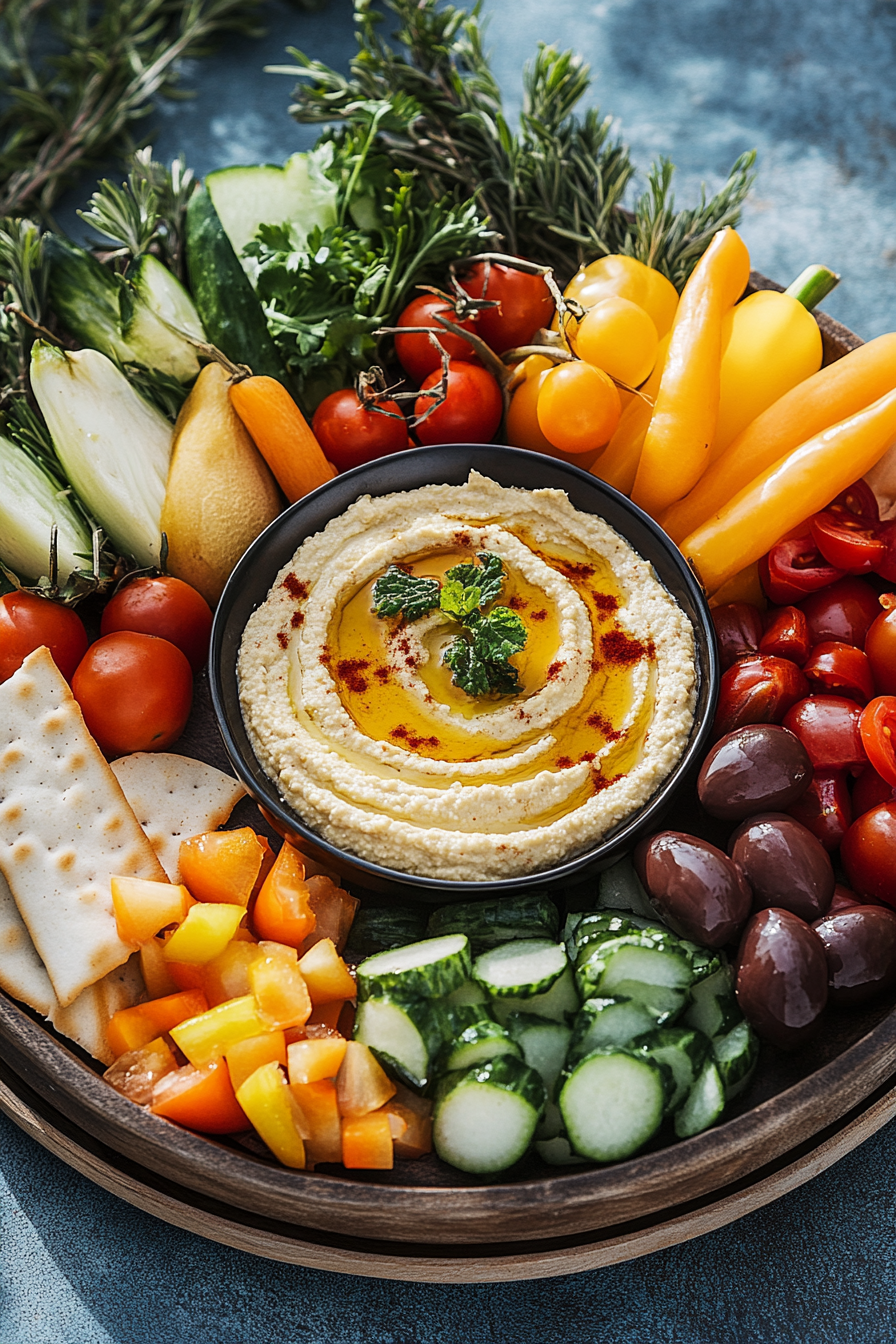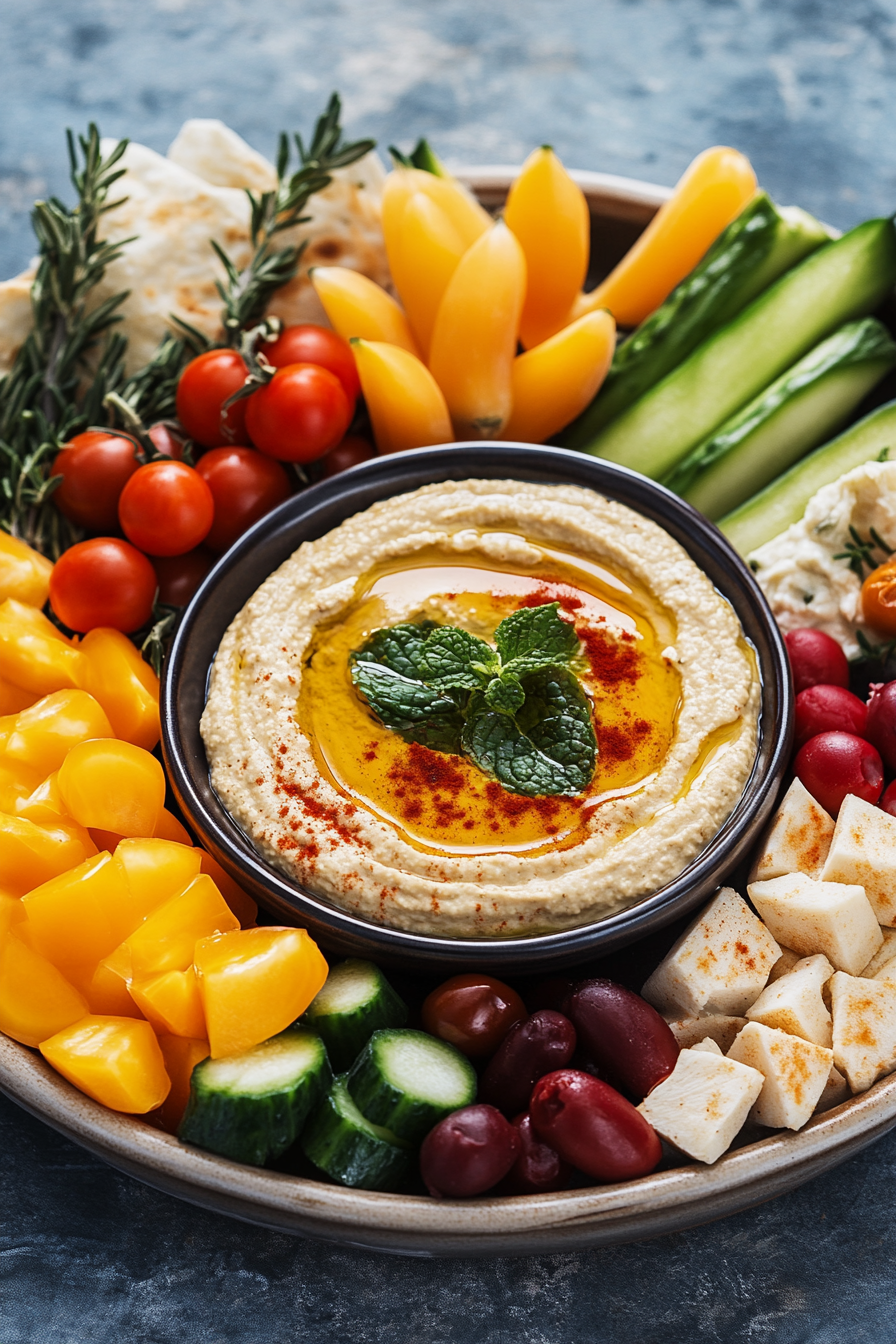Introduction to Hummus and Veggie Platter
Creating a delightful hummus and veggie platter with roasted vegetables is a simple yet delicious recipe that brings a burst of flavors and health benefits to your table. This vegan and gluten-free option includes vibrant veggies like carrots, bell peppers, and cucumbers, complemented by creamy hummus. Perfect for home cooks, busy parents, and diet-conscious individuals, this versatile dish can be easily customized to suit various tastes and dietary needs. Discover the joy of arranging a colorful medley of fresh produce alongside your choice of classic or flavored hummus, making it an ideal choice for any meal or gathering.
Benefits and Advantages of Hummus and Veggie Platter
The hummus and veggie platter offers numerous benefits that make it a standout choice for various occasions. This recipe’s ease of preparation and versatility allow it to be quickly assembled for any event, from casual snacks to sophisticated gatherings. Health-wise, it provides a nutritious blend of plant-based fiber, healthy fats, and essential nutrients. Furthermore, the platter is easily adaptable to different dietary preferences, ensuring inclusivity for everyone from vegans to those on gluten-free diets. By arranging fresh, colorful vegetables around the hummus, you enhance not only its visual appeal but also provide a refreshing, healthy option for all to enjoy.
Ingredients Overview
Essential Ingredients for Hummus and Veggie Platter
- Hummus: Choose from a variety of flavors like classic, roasted garlic, or roasted red pepper. Each offers a distinct taste to amp up your platter.
- Fresh Vegetables: A colorful medley such as:
- Carrots, sliced into sticks
- Cucumbers, cut into rounds
- Bell peppers, sliced into strips
- Cherry tomatoes, halved
- Broccoli florets
- Cauliflower florets
- Sugar snap peas
- Radishes, thinly sliced
- Crackers or Pita Bread: Whole grain for health-conscious options.
- Extras: Enhance your platter with olives, assorted nuts, dried fruit, and marinated cheese for added variety and texture.
Dietary Substitutions to Customize Your Hummus and Veggie Platter
For those adhering to specific dietary requirements or looking to experiment with flavors, consider the following substitutions:
- Vegan Options: Ensure hummus is vegan-approved or make homemade hummus using chickpeas and tahini without any animal products.
- Gluten-Free Alternatives: Opt for gluten-free crackers or chips to cater to gluten-sensitive guests.
- Low-Calorie Choices: Use more fresh vegetables and limit high-calorie extras like nuts and cheese.
- Different Flavor Profiles: Experiment with spicy hummus for a tangy kick or try adding herbs like cilantro for a fresh twist.
The choices for customizing your hummus and veggie platter are nearly endless, allowing you to cater to a wide array of tastes and dietary needs seamlessly.
How to Prepare the Perfect Hummus and Veggie Platter: Step-by-Step Guide
Creating a sensational hummus and veggie platter is not only simple but also an enjoyable process. Follow these steps to craft a stunning dish that will delight any crowd.
- First Step: Choose Your Platter
Select a large serving platter, wooden board, or a combination of smaller plates, ensuring plenty of space for all your ingredients.
- Second Step: Prepare Your Vegetables
Wash all vegetables thoroughly. Cut them into suitable sizes: slice cucumbers into rounds, carrots into sticks, and peppers into strips. Arrange these beautifully around the platter.
- Third Step: Include Hummus
Spoon the hummus into small bowls or place it directly onto the platter, nestled amongst the veggies. Include a variety of flavors for an exciting mix.
- Fourth Step: Add Extras
Intersperse olives, nuts, and dried fruits among the vegetables, adding texture and flavor. Consider marinating cheese cubes or including herbed soft cheese.
- Fifth Step: Roast Vegetables (Optional)
If using roasted vegetables, ensure they are fully cooled before adding them to your arrangement for varied taste and texture.
- Sixth Step: Presentation Matters
Carefully arrange items by color and size to create an eye-catching presentation. This visual appeal enhances the overall dining experience.
- Seventh Step: Final Touches
Drizzle any desired herbs or spice over the hummus, such as paprika or olive oil, to add a final touch of flavor and aesthetics.
By following these steps, your hummus and veggie platter will not only taste delightful but also serve as a centerpiece for gatherings, perfect for satisfying any crowd. Whether crafted for a casual snack or served during a festive occasion, this dish promises to be both pleasing to the eye and the palate. For inspiration, check out our buttermilk sweet Alabama pecanbread or strawberry cheesecake stuffed cookies for additional rustic yet sophisticated snack ideas.

Mastering Hummus and Veggie Platter: Advanced Tips and Variations
Creating a visually appealing and delicious hummus and veggie platter is an art that can be easily mastered with a few advanced tips and variations. While the basic preparation is straightforward, adding creative touches can transform your platter into a culinary masterpiece that impresses both in taste and presentation.
Enhancing Flavor Profiles
Experimenting with a variety of hummus flavors is a great way to enrich your platter. Consider incorporating roasted garlic hummus for a sweet and savory twist, or try a spicy variant to add a kick. Adding herbs such as cilantro or parsley can freshen up the taste and bring a unique aroma to the dish. Don’t hesitate to drizzle some high-quality olive oil or sprinkle paprika for extra flavor depth.
Roasting for Enhanced Textures
Incorporating roasted vegetables can add a delightful contrast to the fresh vegetables typically used in a hummus platter. Roasting vegetables like bell peppers, zucchini, and carrots not only deepens their flavors but also gives a pleasant chewy texture that complements the creamy hummus. Marinate vegetables in your choice of spices before roasting to infuse them with added flavor dimensions.
Creative Presentation Ideas
Arranging the items on a wide wooden board or platter can make a striking difference in presentation. Play with colors by segmenting different veggies and hummus types to create a vibrant mosaic. Use small bowls for different hummus flavors and place them strategically to guide the eater’s journey. Sprinkle a handful of nuts like almonds or walnuts to add crunch and visual appeal.
Innovative Additions
Think beyond the traditional accompaniments for hummus. Adding marinated cheese, olives, and even a selection of dried fruits like apricots or figs can add layers of flavor and texture. These extras make the platter more versatile for different occasions, whether it’s a casual get-together or a formal gathering.
Finally, exploring different cultures’ culinary traditions can introduce new ingredients and styles to your platter. Sourcing ideas from Mediterranean recipes, like those found at Valentina Recipes, can inspire themes and ingredients you might not have considered. By combining creativity with tried-and-true techniques, you will elevate your hummus and veggie platter to new exciting culinary heights.
How to Store Hummus and Veggie Platter: Best Practices
Ensuring your hummus and veggie platter stays fresh and delicious requires understanding the best storage practices. Proper storage can extend the platter’s shelf life, allowing preparation ahead of events or simply saving leftovers efficiently.
Refrigeration Techniques
To maintain freshness, store hummus separately from the vegetables. Place the hummus in airtight containers, ideally glass or BPA-free plastic. Keeping the hummus sealed minimizes the risk of it absorbing fridge odors and helps preserve its creamy texture. For the veggies, wash and dry them thoroughly before packing into breathable bags or containers to maintain their crispness.
Freezing Considerations
Hummus freezes well, making it ideal for long-term storage. Scoop hummus into an airtight container, leaving some space at the top to allow for expansion. Label and date your containers for easy reference. Defrost freezer-stored hummus in the fridge and stir it well before serving to reintegrate any separated oil.
Extending Shelf Life
If stored correctly, hummus can last one week in the fridge, while many fresh vegetables retain their quality for several days. For optimal storage, consume cut vegetables within a few days, maximizing flavor and nutritional benefits. Mix in a drizzle of lemon juice with veggies before storing to help preserve freshness.
By adhering to these storage guidelines, you can enjoy your hummus and veggie platter beyond just the day of preparation, ensuring its flavor and quality endure. Consider additional resources on nutrition and storage for further details. Always keep your pantry stocked with fresh ingredients, and remember to adjust these practices depending on your local climate and the specific items you’ve chosen for your platter.

Nutritional Value of Hummus and Veggie Platter
A hummus and veggie platter is not only a feast for the eyes and taste buds but also a powerhouse of nutrition. Understanding the nutritional value of this dish can help you appreciate its health benefits. Let’s break down the essential nutrients this platter offers.
Caloric Content
On average, a serving of the hummus and veggie platter can range between 200-300 calories depending on the portions and types of vegetables used. Including roasted vegetables may slightly increase the calorie count, but they add a significant amount of flavor and texture.
Protein and Fiber
Hummus, made primarily from chickpeas, is an excellent source of plant-based protein. A typical serving can provide about 6-8 grams of protein. In addition, both chickpeas and vegetables are rich in dietary fiber, aiding in digestion and keeping you full longer.
Vitamins and Minerals
The array of vegetables used in the platter, such as carrots, bell peppers, and cucumbers, are packed with vitamins such as A, C, and K. These vitamins are essential for maintaining good vision, boosting immunity, and promoting bone health.
Healthy Fats
Olive oil used in hummus provides healthy monounsaturated fats, which are beneficial for heart health. Additionally, when nuts or olives are included, they contribute additional healthy fats and flavor.
To learn more about the comprehensive nutritional benefits of hummus, visit this informative article on Healthline’s guide to hummus nutrition.
FAQs: Frequently Asked Questions About Hummus and Veggie Platter
1. What types of hummus are best for a hummus and veggie platter?
A variety of hummus flavors can enhance your veggie platter, making it more appealing. Classic hummus works well as a base, but roasted garlic and roasted red pepper add a delightful twist. For those who prefer a bit of heat, a spicy hummus can offer the perfect kick.
2. What vegetables are commonly used in a hummus and veggie platter?
Common vegetables used in a hummus and veggie platter include carrots, cucumbers, bell peppers, cherry tomatoes, broccoli, cauliflower, sugar snap peas, and radishes. These vegetables offer a range of textures and colors, making the platter visually appealing and tasteful.
3. Can a hummus and veggie platter be prepared ahead of time?
Absolutely! Preparing a hummus and veggie platter ahead of time is not only possible but also convenient. You can wash, cut, and store the vegetables in airtight containers in the refrigerator. Likewise, hummus can be made in advance and stored in the fridge, ensuring everything is fresh when served.
4. What other items can be added to a hummus and veggie platter for extra variety?
To add variety and enhance your platter, consider adding items like olives, nuts, marinated cheese, or dried fruits. These additions provide extra flavors and textures, making the platter more delightful. Incorporating roasted vegetables can also boost both the flavor and nutritional value.
For a deeper understanding of hummus, you might find this section from Britannica’s article on hummus helpful.
Print
Hummus and Veggie Platter with Roasted Vegetables
- Total Time: 15 minutes
Description
🥗 Treat yourself to a colorful and nutritious Hummus and Veggie Platter, packed with fresh veggies, creamy hummus, and tasty extras for the perfect snack or party dish! 🌿
🍽️ Simple to prepare and customizable to your taste, this vibrant platter is a delicious way to enjoy wholesome ingredients while impressing your guests with a stunning presentation! 🌟
Ingredients
Hummus (classic, roasted garlic, roasted red pepper, or spicy)
Carrots
Cucumbers
Bell peppers
Cherry tomatoes
Broccoli
Cauliflower
Sugar snap peas
Radishes
Pita bread or crackers
Olives
Nuts (such as almonds or walnuts)
Dried fruit (such as apricots or figs)
Marinated cheese (such as feta or mozzarella)
Fresh herbs (such as parsley or cilantro)
Spices (such as paprika or cumin)
Olive oil for drizzling
Instructions
1. Gather a variety of fresh vegetables such as carrots, cucumbers, bell peppers, cherry tomatoes, broccoli, cauliflower, sugar snap peas, and radishes.
2. Wash and cut the vegetables into bite-sized pieces or sticks for easy dipping.
3. Choose different flavors of hummus such as classic, roasted garlic, roasted red pepper, or spicy.
4. Arrange hummus in small bowls or directly on the platter for easy access.
5. Include crackers, pita bread, or pita chips as dippable options.
6. Add extras like olives, nuts, dried fruit, or marinated cheese for more variety.
7. For added texture and flavor, roast some vegetables like bell peppers or cauliflower.
8. If using store-bought hummus, enhance it with herbs, spices, or a drizzle of olive oil.
9. Arrange all ingredients on a large platter, wooden board, or multiple small plates for visual appeal.
10. Use a variety of colors, shapes, and textures to make the platter more interesting.
11. Refrigerate until ready to serve, or prepare just before serving for maximum freshness.
12. Serve as a healthy appetizer, snack, or party platter for guests to enjoy.
Notes
Use a mix of colorful vegetables, different hummus flavors, and a variety of textures to make the platter visually appealing and delicious.
Prepare the platter ahead of time and store it in the refrigerator for a convenient and fresh snack or party appetizer.
Drizzle olive oil, sprinkle spices, or add herbs to store-bought hummus for extra flavor and a homemade touch.
- Prep Time: 15
- Category: Appetizer
- Method: No Cook
- Cuisine: Middle Eastern


